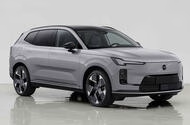The Volvo XC70 is making a comeback, and it’s stirring up excitement in the automotive world. This new plug-in hybrid (PHEV) version is set to bridge the gap between traditional combustion engines and the electric future, catering to a growing demand for longer-range hybrids, especially in markets like China. Let’s dive into what makes this vehicle noteworthy and what it could mean for drivers looking for a versatile, eco-friendly option.
What’s New with the XC70?
The XC70 is no longer just a high-riding estate; it’s evolving into a full-fledged SUV, positioned snugly between the XC60 and XC90 in Volvo’s lineup. With dimensions of 4815mm in length and 1890mm in width, it competes closely with models like the Volkswagen Tayron and Hyundai Santa Fe. However, unlike its competitors and even its larger sibling, the XC90, the XC70 will launch with a five-seat configuration, making it a practical choice for families or anyone needing extra space.
The real star of the show, though, is the powertrain. The XC70 will be available with two battery options: a 21.2kWh battery providing around 62 miles of electric range or a more robust 39.6kWh battery that extends that range to an impressive 112 miles, based on China’s generous CLTC cycle. This larger battery is comparable to those found in other electric vehicles, such as the Abarth 500e, indicating that Volvo is serious about offering a competitive hybrid option.
Why Choose a Plug-In Hybrid?
Volvo’s CEO, Håkan Samuelsson, has been vocal about the role of extended-range PHEVs in the transition to electrification, especially in regions where charging infrastructure is still developing. He argues that for many drivers, particularly in southern and eastern Europe, a long-range hybrid can effectively serve as an “electric car” most of the time, with the petrol engine acting as a backup when needed. This pragmatic approach recognizes that not all consumers are ready to make the leap to fully electric vehicles just yet.
The XC70’s design reflects this philosophy. By focusing on a hybrid model, Volvo aims to meet the needs of those who want the benefits of electric driving without the range anxiety that can come with fully electric vehicles. It’s a smart move, especially as the automotive landscape continues to evolve.
What’s Next for the XC70?
Set to launch in China later this year, the XC70 is positioned as a response to the strong demand for hybrids in that market. However, there’s potential for a European launch, especially as Volvo explores additional markets. The company is committed to becoming fully electric, but it recognizes that premium plug-in hybrids like the XC70 can serve as a bridge for customers who aren’t quite ready to make the switch.
The XC70 is built on a new architecture designed specifically for long-range PHEVs, indicating that Volvo is investing in this segment for the long haul. This architecture is part of a broader strategy that includes collaborating with other brands under the Geely umbrella, which could lead to innovative developments in hybrid technology.
A Look Back at the XC70 Legacy
Interestingly, the XC70 nameplate has been dormant since 2016, when the off-road variant of the third-generation V70 estate was discontinued. Originally known as the V70 XC, the XC70 has a legacy that blends ruggedness with luxury, making it a beloved choice among Volvo enthusiasts. This revival not only brings back a familiar name but also reintroduces a model that aligns with contemporary automotive trends.
As we look forward to its release, the XC70 stands out as a compelling option for those seeking a versatile vehicle that balances performance, practicality, and environmental consciousness.
The big takeaway? The XC70 isn’t just about nostalgia; it’s about embracing change while catering to the needs of today’s drivers. If you’re considering a hybrid, keep an eye on this one—it could be the perfect fit for your lifestyle.

